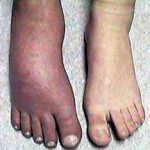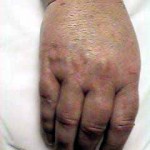An Introduction to Reflex Sympathetic Dystrophy (RSD)
When you sprain an ankle, first you feel a sharp electric pain, and then you feel a burning pain. The sharp pain comes from the fast pain fiber, and the burning pain comes from the sympathetic nerve fiber. Normally the burning pain stops over time.
Sometimes, however, the burning will not stop. In addition, the painful part may always feel cold, and sensitivity to cold temperature, rain or falling barometric pressure can occur. If the condition becomes more severe, then the skin can become sweaty, change colors, and become painful to move. A natural tendency to avoid touch by anyone or anything develops. We call this Reflex Sympathetic Dystrophy (RSD) Stage 1.

With RSD there is a decrease in the local blood flow to the injury site, even after it should have healed. If allowed to persist, then the cold, sweaty, and swollen skin progressively gets worse until there is loss of range of motion or even loss of muscle mass. This is called Stage 2. In some cases the bones may thin as well (Stage 3).
RSD almost always begins after an identifiable event such as a crush injury, torn ligament, or fracture. The initial injury may seem minor, or be severe. Since most health care providers are not familiar with the proper diagnosis of sympathetic pain, it is important for anyone with these complaints to be aware of it.
In RSD, the sympathetic nerve is felt to be overacting. Liken it to a car engine that is dieseling: the ignition is off, yet the engine is still on. In this case the sympathetic nerve stays on, even when the injury itself is old and no longer represents a new injury.
Diagnosis of this disorder requires special expertise. Most doctors do not know how to recognize the condition and those that do will either perform a sympathetic block (to try to shut down the dieseling, decrease pain, and increase blood flow) or run specialized testing like medical thermography. However, you have to be careful because failure to respond to a sympathetic block is not really adequate to prove or disprove the diagnosis, and there are still very few medical doctors trained in the proper use of medical thermography.
Using sympathetic block as the sole diagnostic criteria leaves a lot to be desired because many people suspected of having RSD still complain of pain, even after the block has been done. While doctors have a tendency to blame psychological factors when relief does not occur, there are clearly those who have obvious physical signs of injury and others who have persisted with their complaints in a consistently reliable manner over time.
The two diagnostic tests used to objectify the presence of RSD are bone scans and thermography. The bone scan is felt to be more specific, but the thermogram is more sensitive. Thermography measures skin temperature. When a significant, “asymmetric” pattern exists, the test is said to be positive. Although skin temperature is felt to be under the control of the sympathetic nerve fibers, a positive thermogram only means that there is an abnormal physiologic response to injury. It does not tell what the underlying injury is that generated the response.

Determining the source, or generator of that asymmetry, can be a very complex task. If you believe you have a minor or major form of sympathetic pain, it is wise to seek the assistance of a medical doctor with specialized training in RSD. Once the type of RSD is diagnosed, and the reasons for its perpetration are discovered, there are many effective non-surgical and non-addicting interventions available that can provide relief.





